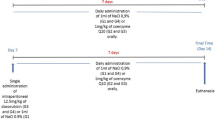Experiments were performed on the model of irreversible myocardial ischemia in Wistar rats. Coenzyme Q10 was injected intravenously 10 min after coronary artery occlusion. On day 21 after myocardial infarction the content of coenzyme Q10 in the left ventricle, liver, and plasma from animals of the treatment group was higher than that in untreated rats by 23, 1042, and 87%, respectively (p<0.05). The area of the necrotic zone was lower, and postinfarction hypertrophy of the left ventricle was less pronounced in coenzyme-receiving rats. Right ventricular hypertrophy did not develop in these animals. These rats were characterized by greater stroke volume (by 24.6%, p<0.05), stroke work (by 34.9%), cardiac output (by 37.8%, p<0.05), ejection fraction (by 35.7%, p<0.05), and contractility (by 22.5%, p<0.05), but lower end-diastolic pressure (by 25.8%, p<0.05) than untreated animals. These data indicate that the development of parenteral ubiquinone preparations holds much promise for urgent therapy of acute cardiovascular disorders.
Similar content being viewed by others
References
H. Bessler, M. Bergman, N. Blumberger, et al., J. Nutr. Sci. Vitaminol. (Tokyo), 56, No. 1, 77–81 (2010).
E. I. Kalenikova, E. A. Gorodetskaya, E. G. Kolokolchikova, et al., Biochemistry (Mosc.), 72, No. 3, 332–338 (2007).
K. Kaur, A. K. Sharma, and P. K. Singal, Am. J. Physiol. Heart Circ. Physiol., 291, No. 1, H106–H113 (2006).
K. Kempf, G. Haltern, R. Futh, et al., Horm. Metab. Res., 38, No. 5, 346–351 (2006).
A. Kumar, H. Kaur, P. Devi, and V. Mohan, Pharmacol. Ther., 124, No. 3, 259–268 (2009).
V. L. Lakomkin, G. G. Konovalova, E. I. Kalenikova, et al., Biochemistry (Mosc.), 70, No. 1, 79–84 (2005).
H. Langsjoen, P. Langsjoen, R. Willis, and K. Folkers, Mol. Aspects Med., 15, Suppl., S165–S175 (1994).
S. L. Molyneux, C. M. Florkowski, P. M. George, et al., J. Am. Coll. Cardiol., 52, No. 18, 1435–1441 (2008).
P. Pacher, T. Nagayama, P. Mukhopadhyay, et al., Nat. Protoc., 3, No. 9, 1422–1434 (2008).
S. Sander, C. I. Coleman, A. A. Patel, et al., J. Card. Fail., 12, No. 6, 464–472 (2006).
C. Schmelzer, G. Lorenz, I. Lindner, et al., Biofactors, 31, No. 1, 35–41 (2007).
M. Sugano, T. Hata, K. Tsuchida, et al., Mol. Cell. Biochem., 266, Nos. 1-2, 127–132 (2004).
K. L. Tsai, Y. H. Huang, C. L. Kao, et al., J. Nutr. Biochem., 23, No. 5, 458–468 (2012).
D. D. Verma, W. C. Hartner, V. Thakkar, et al., Pharm. Res., 24, No. 11, 2131–2137 (2007).
G. J. Whitman, K. Niibori, H. Yokoyama, et al., Mol. Aspects Med., 18, Suppl., S195–S2013 (1997).
Author information
Authors and Affiliations
Corresponding author
Additional information
Translated from Byulleten’ Eksperimental’noi Biologii i Meditsiny, Vol. 155, No. 6, pp. 736-739, June, 2013
Rights and permissions
About this article
Cite this article
Ivanov, A.V., Gorodetskaya, E.A., Kalenikova, E.I. et al. Single Intravenous Injection of Coenzyme Q10 Protects the Myocardium after Irreversible Ischemia. Bull Exp Biol Med 155, 771–774 (2013). https://doi.org/10.1007/s10517-013-2249-3
Received:
Published:
Issue Date:
DOI: https://doi.org/10.1007/s10517-013-2249-3




